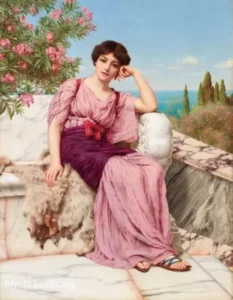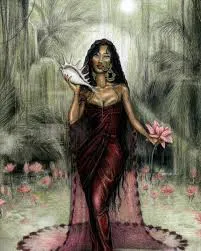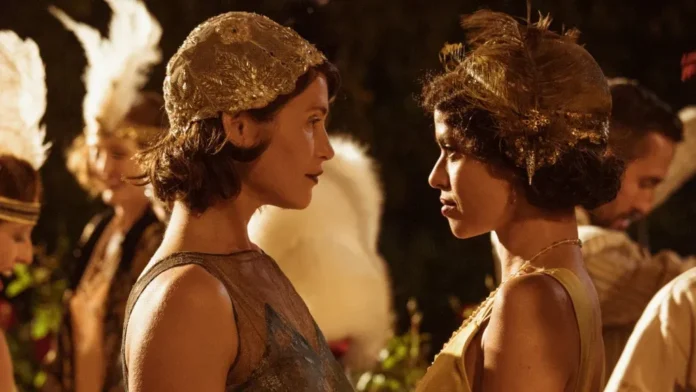The term “lesbian” may be a modern invention, but love between women has existed for millennia. Long before contemporary identities took shape, women across different cultures formed deep, passionate, and often lifelong bonds. Some societies celebrated these relationships, while others kept them in the shadows. Yet, history reveals that female same-sex love was always present, shaping poetry, myth, and everyday life.
Let’s take a journey through time, exploring how ancient civilizations perceived and lived female same-sex love before they had the words to define it.
Ancient Greece: Sappho and the Isle of Lesbos
 No discussion of lesbian history is complete without Sappho, the famed poet from the island of Lesbos (circa 630-570 BCE). Her evocative poetry speaks of longing, admiration, and deep emotional connections with women. Her verses, filled with passion and tenderness, cemented her place as a symbol of female same-sex love.Unlike male homoerotic relationships, which were often structured within mentor-protégé roles, women’s relationships existed in a less rigid framework, making them more elusive in historical records. Still, Sappho’s poetry suggests that such bonds were both acknowledged and deeply felt.
No discussion of lesbian history is complete without Sappho, the famed poet from the island of Lesbos (circa 630-570 BCE). Her evocative poetry speaks of longing, admiration, and deep emotional connections with women. Her verses, filled with passion and tenderness, cemented her place as a symbol of female same-sex love.Unlike male homoerotic relationships, which were often structured within mentor-protégé roles, women’s relationships existed in a less rigid framework, making them more elusive in historical records. Still, Sappho’s poetry suggests that such bonds were both acknowledged and deeply felt.
Rome: Silence and Scorn
The Romans took a far more conservative approach than the Greeks when it came to same-sex female love. Male homoerotic relationships were often documented, but women’s affection for each other received little acknowledgment, except in mockery. Poets like Martial and Ovid referenced women loving women, often in a derogatory or dismissive tone, reflecting a society where such relationships were largely invisible.Despite this, glimpses of female same-sex desire emerge in Roman literature and art, hinting that these relationships persisted despite societal indifference or scorn.
China: The Golden Orchid Societies
In Imperial China, traditional Confucian values emphasized marriage and family, yet some women found ways to build their own paths. The Golden Orchid Societies, which emerged during the Qing Dynasty (1644–1912), allowed women to reject marriage to men in favor of sisterhoods where they formed intense, often romantic bonds. These relationships, while not always explicitly sexual, provided women with a space to love and support each other outside patriarchal norms. Chinese literature and poetry also contain subtle references to female love, often wrapped in metaphor, reflecting both the presence of these relationships and the societal need to keep them discreet.
Japan: Hidden Desires and Sacred Bonds
While male same-sex relationships were openly acknowledged in samurai culture, female same-sex love remained more elusive. However, Buddhist convents created an environment where women formed deep emotional and romantic bonds. Some historical records and Edo-period literature hint at the existence of female lovers, even though they were less publicly acknowledged than their male counterparts.
India: Love in Myth and Reality
 Ancient Indian texts show a fluid understanding of love and gender. The Kamasutra, for example, does not exclude references to women engaging in same-sex acts. Hindu mythology also presents fascinating narratives that blur the lines between gender and sexuality. Mohini, the female incarnation of Vishnu, engages in relationships with both men and women, highlighting a more nuanced perspective on love and identity. Temple carvings and ancient poetry reveal that female same-sex desire was neither unheard of nor necessarily taboo in pre-colonial India. Colonial influences later imposed rigid sexual norms, but the original cultural attitudes were often far more open.
Ancient Indian texts show a fluid understanding of love and gender. The Kamasutra, for example, does not exclude references to women engaging in same-sex acts. Hindu mythology also presents fascinating narratives that blur the lines between gender and sexuality. Mohini, the female incarnation of Vishnu, engages in relationships with both men and women, highlighting a more nuanced perspective on love and identity. Temple carvings and ancient poetry reveal that female same-sex desire was neither unheard of nor necessarily taboo in pre-colonial India. Colonial influences later imposed rigid sexual norms, but the original cultural attitudes were often far more open.
The Middle East: Love in Poetry and Secrecy
In the Islamic Golden Age, female-female love found its way into poetry, though often veiled in metaphor. Arabic and Persian literature contains verses written by women expressing longing and admiration for other women. Though less documented than male same-sex relationships, these poems suggest that female love was not entirely absent from cultural consciousness.
Africa: Woman-Woman Marriages and Warrior Bonds
Several African cultures historically acknowledged diverse gender and sexual expressions. Among the Igbo of Nigeria and the Kikuyu of Kenya, “woman-woman marriages” were a socially accepted institution. These marriages, while not always sexual, allowed women to establish households together and raise children, demonstrating an alternative structure for female relationships. In the Dahomey Kingdom (modern-day Benin), the Agojie (Dahomey Amazons) were an elite force of female warriors who lived and fought together. Oral histories suggest that their bonds extended beyond mere camaraderie, hinting at deep and possibly romantic connections.
The Americas: Two-Spirit Traditions and Sacred Bonds
Many Indigenous cultures in North and South America recognized Two-Spirit individuals—people who embodied both masculine and feminine spirits. These identities often included same-sex relationships, indicating a more fluid understanding of gender and love than the rigid norms imposed by European colonization. Among the Zapotec of Mexico, historical accounts suggest that women sometimes formed lifelong partnerships, though colonial suppression erased much of these narratives. Today, Indigenous groups are reclaiming these histories, ensuring that their traditions of diverse love are remembered.
Europe’s Forgotten Women: Nuns, Nobles, and Romantic Friendships
In medieval Europe, convents became safe spaces where women formed deep, sometimes romantic, relationships. Letters between nuns reveal passionate declarations of love, though the Church largely ignored these bonds as long as they did not disrupt religious duties. The 18th and 19th centuries saw the rise of “romantic friendships”, intensely emotional relationships between women that blurred the line between platonic and romantic love. While society dismissed these relationships as non-threatening, they allowed women to express deep affection in ways that were often indistinguishable from modern understandings of same-sex love.
A Love That Endures
Same-sex love among women has always existed, though it has taken many forms depending on the culture and era. Some societies celebrated it, others ignored it, and some sought to suppress it, but it endured nonetheless. These histories remind us that queerness is not a modern invention but a fundamental part of the human experience.
Today, as LGBTQ+ communities reclaim their past, the echoes of ancient love stories still resonate. While modern terminology gives us new ways to define identity, the essence of love remains unchanged—transcending time, language, and societal norms.


















